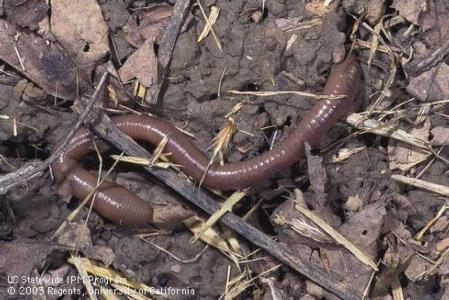Earthworms are commonly associated with “healthy” soils and in many cases they are good indicators. See a previous blog: //ucanr.edu/blogs/blogcore/postdetail.cfm?postnum=23945
In a recent blog, Michigan State University is telling a different story: http://msue.anr.msu.edu/news/the_dirt_about_earthworms
The popular view of earthworms – beneficial creatures that aerate the soil, feed robins and make good fishing bait – may be true in our gardens and tilled farm fields, but in forests it is a different matter.
Earthworms are not native to Michigan and the Great Lakes region, at least not since before glaciers covered the region; they were brought here during European settlement in the 1800s or possibly earlier. Plants, wildlife and forests evolved without any of these creatures around. They are now an invasive species that harms forests.
In gardens and agricultural fields, earthworms help improved soil structure and fertility, but in forests their effects are much different. Hardwood forests without earthworms have a thick layer of slowly decomposing leaves, or “duff” that promotes a rich community of wildflowers, tree seedlings and small animals. Earthworms change that environment dramatically by essentially consuming the duff, thereby destroying habitat and reducing fertility. In contrast to their effect in gardens, earthworms cause forest soils to become more compacted. As a result of habitat loss, fertility declines and soil compaction, these forests may be less productive and have poorer new tree regeneration in the long run.
If that wasn't bad enough, research shows that the combination of excessive browsing by deer (another serious threat to Michigan forests) and high earthworm populations in an area can have a worse effect than either one alone. Also, other invasive species, such as buckthorn, may have an easier time getting established in earthworm-infested areas. Without a diverse forest floor and new seedlings, the long term health of woodlands is threatened.
The connection between climate change and earthworms is complex. A warmer climate and longer growing season may hasten earthworm migration to previously worm-free forests. Introduction of earthworms make them more vulnerable to other climate-related stresses, such as more frequent and longer droughts. Although earthworms may reduce the amount of carbon entering the atmosphere through their soil action, on balance these creatures are a bad deal for northern forests.
Earthworm populations are not the same throughout Michigan forests – some areas have dense populations, others have few or none. They get from place to place very slowly. People, however, can transport them much more quickly on muddy tires, soil moved from place to place, and discarded fishing bait. There is no way to eliminate earthworms once they become established in woodlands.
In California, we have some native species of earthworms, but in many cases, non-native introduced species have come to dominate. The predominant native species belong to the Argilophilus and Diplocardia while many of the non-native are of European in origin in the Lumbricidae family. Many of these non-natives were probably introduced by settlers bringing plants from home, which had soil containing the worms. A survey of California earthworms by the US Forest Service can be found at:
https://www.fs.fed.us/psw/publications/documents/psw_gtr142/psw_gtr142.pdf
This is a wonderful description of earthworm biology and their occurrence in the California landscape.
Attached Images:
